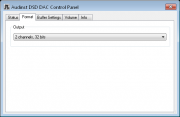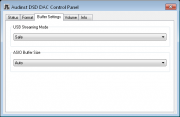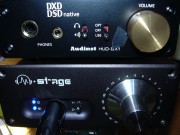leeperry
Galvanically isolated his brain
- Joined
- Apr 23, 2004
- Posts
- 13,823
- Likes
- 1,685
Hey guys, been messing around with this nice little toy for a few weeks now and I figured it would deserve a modding discussion thread here together with my own observations and subjective impressions as in my opinion there is a tremendous amount of potential to unveil from it: http://audinst.com/en/product/hud-dx1/
 so what we got onboard goes as follow:
so what we got onboard goes as follow:
-ES9018
-XMOS USB
-Muses8920 opamps
-TPA6120 headamp
-TCXO clocks
-Toslink input & output
The beautiful thing about being late to the party is that a few existing reviews really match my experience(as some others kept comparing it to their older DAC's that were using ancient chips), such as qobuz's that went very technical but sadly never got an english translation on their UK website as they usually do: http://www.qobuz.com/FR-fr/info/Hi-Res-Guide/Bancs-d-essai/Audinst-HUD-DX1-montee-en177891
A russian site also a posted a great one and even went the extra mile by translating it to english: http://allcompanies.website/2015/12/19/a-review-of-the-audinst-hud-dx1-update-legendary-dac-amplifier/
I'm not keen on repeating what they both said when that last link only really needs quotes as I would rather discuss modifications and technical details than going into purple prose, wild analogies and subjective blabbering so there goes(I fixed grammar glitches here and there):
Well, there ya go so let's get into more details about those points:
-ES9018 is unforgiving(mostly due to Hyperstream) and many companies like to pair it with equally harsh opamps such as LM4562 so in the end many ppl will claim that ES9018 sounds "too digital", not musical, harsh, bright and plain annoying.....facts are that Audinst didn't skimp on their design by going voltage output and put a as many as four Muses8920 at work in order to give it a more "analog" character. Today I saw this subjective impression about 8920 that perfectly applies to the sound of DX1:
So basically they used an army of 8920's in order to color DX1 in a good way, very beefy, smooth and not bright/shrill but most experienced opamps rollers will tell you that stacking the same opamps over and over again usually won't provide optimal results..but more on this later

One thing's for sure, this DAC sounds emotional and gripping, very thick(thanks to the 100mA high current output of all its Muses opamps I would guess, 8920 being especially advised for I/V) and provides a very nice balance between dark and detailed, I would presume that Audinst took a while to release an ES9018 based DAC due to extensive prototyping. I found it interesting to read that The Element DAC from JDS went through as many as "125 development revisions of the PCB" so slapping a bunch of great components doesn't necessarily warrant primo SQ as it would appear and the cost of protoboards has to be accounted for.
For that matter Audinst did feed ES9018K2M with a 100Mhz clock in order to unlock the full potential of Hyperstream:
Point was made when I ran a shoot-out between the $149 SMSL M8 and DX1 as they share the same DAC and USB chips: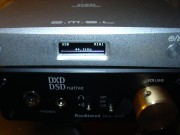
I A/B'ed them a number of times but in comparison M8 always sounded metallic, nasal, thin, grainy with a vastly disorganized soundstage and nothing making any sense within the stereo image, nowhere near as thick sounding, organic and natural as the stock DX1. The extra cost of DX1 is unmissable, cheapies don't do no miracle I'm afraid. I used the same 1ft long furutech DIY RCA cable and ADA4610-powered headamp in both cases, nothing changed and I did A/B them several times with and without my Schiit Wyrd. Not placebo, rolling FIR modes in M8 barely making any audible change.
In one sentence: DX1 plays music, M8 outputs noise. Even wih the stock PSU, DX1 adds a very thick and loud deep bass, natural sounding non-edgy trebles, a far more credible SS, vocals sounds a whole lot more realistic......not the same ballpark really.
About Windows drivers, they're the latest 3.20 offering from XMOS:
Drivers release notes make clear that 32bit integer ASIO is fully functional so basically you can apply DSP(such as crossfeed & EQ) and output as 32int to DX1 straight to ES9018 avoiding 24int roundings, it's also great that Audinst didn't hide the buffer settings(as most manufacturers do) so you can increase it when using a slow computer for instance.
So anyway, it's time to plug DX1 to a proper full-blown headamp such as the Matrix HPA-2(don't mind the tape on the DX1 led as I don't like those while watching movies in the dark):
What we got here is a perfect example of a great headamp with a meh DAC thrown in and a great DAC with a meh headamp as a bonus, I guess they'll save the day if you're on the go or something.
HPA-2 had its opamps rolled and its DC decoupling input caps bypassed, DX1 was fully modded but I'll get to that in a few lines. Long story short, this sounds VERY impressive as in amazing 3D imaging with a very audible depth, very tight and loud deep bass impact, non-shrill mids and trebles oooooouh!
A great demo CD in my experience is the collector's edition of the Pulp Fiction OST: http://www.amazon.com/dp/B00006F1LX
It's hard to miss that they went very serious with mastering on this one and it really got me to hear the full 3D potential of DX1 because as usual the "garbage in garbage out" principle very much applies and if you feed it lo-res material it won't sound dull or anything but certainly won't allow DX1 to showcase you its real talent.
So I keep mentioning that DX1 can be pimped, three points can be easily improved:
1) external PSU, as it ships with a lightweight 15V/1A SMPS
2) USB PSU, as its XMOS chip is bus-powered(easy to verify as a USB cable that had its +5V pin severed doesn't allow it to mount)
3) opamps, as two of the Muses8920 were kindly fitted onto DIP8 swappable sockets

1) the easiest mod is probably the external PSU, I like to hoard vintage heavy transformers from garage sales and so as they always come in handy and are usually sold for a buck. Audinst give a 12V<->15V spec for it and I did happen to have a good contender at hand:
Super heavy, a bit over 14V at idle, we're in business

I A/B'ed it against the stock one a number of times and yeah, even better bass response, even deeper SS, more natural mids, we are definitely listening to PSU's.
2) I fed it to my Schiit Wyrd(that also had its 6VAC transformer replaced by a twice beefier one, hence the DC plug adapter):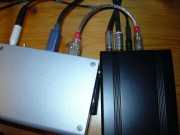
Well, it ain't pretty hah.....the nasty thing with audio is that you never know what you've been missing till you hear it and Wyrd both reclocks the USB data and injects a very low noise linear PSU, all I can say is that the effect is readily audible and quite drastic providing a much more natural and dynamic sound. There's only so much you can expect from the computer host +5V.
While A/B'ing with and without Wyrd, I also tried to unplug the external PSU and go USB-powered only but that wasn't pretty either, mostly because from what the user manual says opamps are fed ±5V off USB power only and ±12V off the external PSU, more voltage swing allowing for higher sound quality. I also heard static for a second or so when rolling USB PSU's but that would be normal from what their website says:
So ideally you should first plug the external PSU and then the USB cable.
3) opamps, the main course and I got explosives:
This is the stock board:
Audinst got a FAQ entry on their site with all the infos we need, long story short I/V from ES9018 is fed to U7 then to U10 and together they feed both the line-out and headamp.
In the user manual Audinst advise rolling LME49990, OPA627 and a few others.
It should be noted that they didn't skimp on opamp decoupling and you can see a whole bunch of WIMA's and ceramic caps around the DIP8 sockets, basically all components that start with a "C" in the DIP8 sockets area are here to stabilize them(avoiding oscillation as much as can be) and make them sound better(picture kindly provided by qobuz):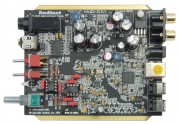
An utterly OCD'ed opamp roller told me that slapping giant caps onto opamps modules would pretty much be uncalled for so that's a good sign.
As a matter of fact, I did quite a lot of rolling(being a lego lover at heart I guess ^^):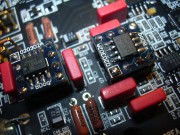
Once you roll unforgiving opamps such as LME49990 & ADA4627-1B it's easy to hear why Audinst chose the darker 8920 option because too much of a good thing.......in my experience it's better to use a very clear sounding chip in U7 and then have it colored by a somewhat less detailed & more laid-back chip in U10.
My best combo by quite a large margin was OPA1641 in U7 and OPA602BP in U10, the former being part of their "Sound-Plus" serie that was released a few years back and the latter a cousin of OPA627 and providing a very enjoyable experience that quite a lot of rollers thoroughly enjoy for a good reason to my ears.
Now to what I didn't like in DX1:
-its not a true line-out and the front volume control cannot be bypassed, a jumper on the board would have been much appreciated but then again stereo tracking at max volume is perfect so no biggy
-the vanilla TPA6120 built-in headamp doesn't quite match the high resolution of the line-out, I really tried to find opamps combinations that would make it sing and it ended up being a no-go in all cases but then again $400 for such a great sounding DAC with such high potential is nothing to sneeze at and as far as I can see designing a headamp and a DAC are both very different jobs requiring a lot of R&D on their own so a single box providing equally good ones takes some (very) serious dough. I guess I should state that I'm using hard-to-drive vintage planar headphones so YMMV.
Hope you enjoyed the read, hopefully I'll have enticed existing owners to pimp theirs and I'll be looking forward your comments & crazy mods then


-ES9018
-XMOS USB
-Muses8920 opamps
-TPA6120 headamp
-TCXO clocks
-Toslink input & output
The beautiful thing about being late to the party is that a few existing reviews really match my experience(as some others kept comparing it to their older DAC's that were using ancient chips), such as qobuz's that went very technical but sadly never got an english translation on their UK website as they usually do: http://www.qobuz.com/FR-fr/info/Hi-Res-Guide/Bancs-d-essai/Audinst-HUD-DX1-montee-en177891
A russian site also a posted a great one and even went the extra mile by translating it to english: http://allcompanies.website/2015/12/19/a-review-of-the-audinst-hud-dx1-update-legendary-dac-amplifier/
I'm not keen on repeating what they both said when that last link only really needs quotes as I would rather discuss modifications and technical details than going into purple prose, wild analogies and subjective blabbering so there goes(I fixed grammar glitches here and there):
Despite the external similarity with their previous offerings, DX1 has almost everything changed.
..
we have to admit that for $400 device gives a lot.
..
The bass is fast, focused and very sharp. It features a good depth
..
MIDs — slightly cool and detailed.
..
The company has managed to avoid the harshness inherent in substandard implementations of the DAC from ESS
Well, there ya go so let's get into more details about those points:
-ES9018 is unforgiving(mostly due to Hyperstream) and many companies like to pair it with equally harsh opamps such as LM4562 so in the end many ppl will claim that ES9018 sounds "too digital", not musical, harsh, bright and plain annoying.....facts are that Audinst didn't skimp on their design by going voltage output and put a as many as four Muses8920 at work in order to give it a more "analog" character. Today I saw this subjective impression about 8920 that perfectly applies to the sound of DX1:
8820 soundstage is wider but 8920 SS is deeper, 8820 sounds a bit more clear and balanced, 8920 sounds darker and smoother, more analog-like. I prefer 8920 to 8820.
So basically they used an army of 8920's in order to color DX1 in a good way, very beefy, smooth and not bright/shrill but most experienced opamps rollers will tell you that stacking the same opamps over and over again usually won't provide optimal results..but more on this later

One thing's for sure, this DAC sounds emotional and gripping, very thick(thanks to the 100mA high current output of all its Muses opamps I would guess, 8920 being especially advised for I/V) and provides a very nice balance between dark and detailed, I would presume that Audinst took a while to release an ES9018 based DAC due to extensive prototyping. I found it interesting to read that The Element DAC from JDS went through as many as "125 development revisions of the PCB" so slapping a bunch of great components doesn't necessarily warrant primo SQ as it would appear and the cost of protoboards has to be accounted for.
For that matter Audinst did feed ES9018K2M with a 100Mhz clock in order to unlock the full potential of Hyperstream:

Point was made when I ran a shoot-out between the $149 SMSL M8 and DX1 as they share the same DAC and USB chips:

I A/B'ed them a number of times but in comparison M8 always sounded metallic, nasal, thin, grainy with a vastly disorganized soundstage and nothing making any sense within the stereo image, nowhere near as thick sounding, organic and natural as the stock DX1. The extra cost of DX1 is unmissable, cheapies don't do no miracle I'm afraid. I used the same 1ft long furutech DIY RCA cable and ADA4610-powered headamp in both cases, nothing changed and I did A/B them several times with and without my Schiit Wyrd. Not placebo, rolling FIR modes in M8 barely making any audible change.
In one sentence: DX1 plays music, M8 outputs noise. Even wih the stock PSU, DX1 adds a very thick and loud deep bass, natural sounding non-edgy trebles, a far more credible SS, vocals sounds a whole lot more realistic......not the same ballpark really.
About Windows drivers, they're the latest 3.20 offering from XMOS:
Drivers release notes make clear that 32bit integer ASIO is fully functional so basically you can apply DSP(such as crossfeed & EQ) and output as 32int to DX1 straight to ES9018 avoiding 24int roundings, it's also great that Audinst didn't hide the buffer settings(as most manufacturers do) so you can increase it when using a slow computer for instance.
So anyway, it's time to plug DX1 to a proper full-blown headamp such as the Matrix HPA-2(don't mind the tape on the DX1 led as I don't like those while watching movies in the dark):
What we got here is a perfect example of a great headamp with a meh DAC thrown in and a great DAC with a meh headamp as a bonus, I guess they'll save the day if you're on the go or something.
HPA-2 had its opamps rolled and its DC decoupling input caps bypassed, DX1 was fully modded but I'll get to that in a few lines. Long story short, this sounds VERY impressive as in amazing 3D imaging with a very audible depth, very tight and loud deep bass impact, non-shrill mids and trebles oooooouh!
A great demo CD in my experience is the collector's edition of the Pulp Fiction OST: http://www.amazon.com/dp/B00006F1LX
It's hard to miss that they went very serious with mastering on this one and it really got me to hear the full 3D potential of DX1 because as usual the "garbage in garbage out" principle very much applies and if you feed it lo-res material it won't sound dull or anything but certainly won't allow DX1 to showcase you its real talent.
So I keep mentioning that DX1 can be pimped, three points can be easily improved:
1) external PSU, as it ships with a lightweight 15V/1A SMPS
2) USB PSU, as its XMOS chip is bus-powered(easy to verify as a USB cable that had its +5V pin severed doesn't allow it to mount)
3) opamps, as two of the Muses8920 were kindly fitted onto DIP8 swappable sockets

1) the easiest mod is probably the external PSU, I like to hoard vintage heavy transformers from garage sales and so as they always come in handy and are usually sold for a buck. Audinst give a 12V<->15V spec for it and I did happen to have a good contender at hand:

Super heavy, a bit over 14V at idle, we're in business

I A/B'ed it against the stock one a number of times and yeah, even better bass response, even deeper SS, more natural mids, we are definitely listening to PSU's.
2) I fed it to my Schiit Wyrd(that also had its 6VAC transformer replaced by a twice beefier one, hence the DC plug adapter):

Well, it ain't pretty hah.....the nasty thing with audio is that you never know what you've been missing till you hear it and Wyrd both reclocks the USB data and injects a very low noise linear PSU, all I can say is that the effect is readily audible and quite drastic providing a much more natural and dynamic sound. There's only so much you can expect from the computer host +5V.
While A/B'ing with and without Wyrd, I also tried to unplug the external PSU and go USB-powered only but that wasn't pretty either, mostly because from what the user manual says opamps are fed ±5V off USB power only and ±12V off the external PSU, more voltage swing allowing for higher sound quality. I also heard static for a second or so when rolling USB PSU's but that would be normal from what their website says:
It is normal to hear a distorted sound temporarily when you connect or disconnect the adaptor during use, since the distorted sound is a phenomena occurring when the protective circuit operates.
So ideally you should first plug the external PSU and then the USB cable.
3) opamps, the main course and I got explosives:

This is the stock board:

Audinst got a FAQ entry on their site with all the infos we need, long story short I/V from ES9018 is fed to U7 then to U10 and together they feed both the line-out and headamp.
In the user manual Audinst advise rolling LME49990, OPA627 and a few others.
It should be noted that they didn't skimp on opamp decoupling and you can see a whole bunch of WIMA's and ceramic caps around the DIP8 sockets, basically all components that start with a "C" in the DIP8 sockets area are here to stabilize them(avoiding oscillation as much as can be) and make them sound better(picture kindly provided by qobuz):

An utterly OCD'ed opamp roller told me that slapping giant caps onto opamps modules would pretty much be uncalled for so that's a good sign.
As a matter of fact, I did quite a lot of rolling(being a lego lover at heart I guess ^^):

Once you roll unforgiving opamps such as LME49990 & ADA4627-1B it's easy to hear why Audinst chose the darker 8920 option because too much of a good thing.......in my experience it's better to use a very clear sounding chip in U7 and then have it colored by a somewhat less detailed & more laid-back chip in U10.
My best combo by quite a large margin was OPA1641 in U7 and OPA602BP in U10, the former being part of their "Sound-Plus" serie that was released a few years back and the latter a cousin of OPA627 and providing a very enjoyable experience that quite a lot of rollers thoroughly enjoy for a good reason to my ears.
Now to what I didn't like in DX1:
-its not a true line-out and the front volume control cannot be bypassed, a jumper on the board would have been much appreciated but then again stereo tracking at max volume is perfect so no biggy
-the vanilla TPA6120 built-in headamp doesn't quite match the high resolution of the line-out, I really tried to find opamps combinations that would make it sing and it ended up being a no-go in all cases but then again $400 for such a great sounding DAC with such high potential is nothing to sneeze at and as far as I can see designing a headamp and a DAC are both very different jobs requiring a lot of R&D on their own so a single box providing equally good ones takes some (very) serious dough. I guess I should state that I'm using hard-to-drive vintage planar headphones so YMMV.
Hope you enjoyed the read, hopefully I'll have enticed existing owners to pimp theirs and I'll be looking forward your comments & crazy mods then



